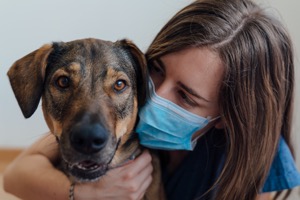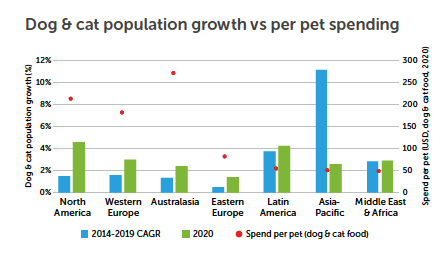Prescription for pandemic-resistant growth

Global pet care thrives despite a difficult macro-environment.
Unprecedented
Calling 2020 an ‘unprecedented’ year may well be an understatement. As the COVID-19 pandemic closed borders and nearly shut down entire sectors of the global economy, millions lost their jobs. Global GDP growth plummeted more dramatically than during the 2008-2009 financial crisis. So the pet care industry faced significant uncertainty as the year unfolded.
But pet care not only thrived during the pandemic, it also posted its strongest growth on record – by a wide margin. What drove this rapid growth despite the deteriorating global economy?
More pets… in the right places
Social isolation is a hallmark of the pandemic. Under strict quarantine or stay-at-home orders, people turned to pets for companionship. So many markets reported a surge in first-time pet owners. This was not a universal trend, however. In some emerging markets, pet ownership struggled with misinformation linking pets to the virus, economic constraints or policy responses to COVID.
In Europe, North America and Australasia, pet population growth accelerated from its pre-pandemic baseline by a factor of two or three. Besides more demand for companionship, a shift to remote work made pet ownership possible for households who could not previously care for a pet. Meanwhile, pet population growth slowed dramatically in Asia and saw little improvement in Latin America or in the Middle East and Africa.
While global growth remained in line with historic trends, the increase in developed markets that spend on average four to five times as much per pet helped to accelerate industry growth.
Shift to higher-income households
The pandemic’s economic fallout was also highly uneven. Workers in service industries like entertainment, hospitality or travel found themselves out of work and struggling to make ends meet. White-collar workers, on the other hand, were largely able to transition to remote work and keep their jobs. In the context of pet ownership, much of the surge was therefore within these higher-income households that could spend more on premium food and non-food supplies.
‘Are there pets living in your home/yard?’ Change in respondents by income band, 2019 vs 2020
Source: Euromonitor Voice of the Consumer: Lifestyles. Survey; fielded in January/February of 2020 and 2021 (used for 2019 and 2020, respectively)
This explains many unique features of the industry’s growth in 2020. Premium pet food once again saw significant share gains over economy or mid-priced brands, while private label lost share.
Non-food supplies – typically less of a necessity – saw sales growth surge even higher than pet food. These trends may seem a bit counter-intuitive during a severe recession, but this dramatic shift towards higher-income households can help explain the rapid growth.
Deeper bonds
Global respondents to Euromonitor International’s Lifestyles Survey describing their pets as ‘beloved members of the family’ jumped more than 1.5pp from 2019 to reach 70.9% in 2020 – an all-time high. This status helps drive industry growth, as pet owners are then more likely to buy premium food and humanising supplies.
And more time at home also means more ‘treating occasions’, as value sales of treats surged by 11% to emerge as the fastest-growing segment within pet food. With mobility patterns shifting away from workplaces, shopping malls and restaurants to parks, pets enjoy significantly more time with their owners who, in turn, form deeper bonds with their companions.
Bright outlook
While growth in 2021 is expected to slow from its historic high, Euromonitor International projects that pet care will significantly outperform its pre-pandemic baseline. Most people who brought pets into their homes in 2020 will keep these new family members, creating an elevated pet population for the future.
As employers increasingly implement long-term remote work arrangements, more high-income households will enter the market. And as humanisation trends drive interest in premium food and supplies, the global market is ripe for continued growth.


